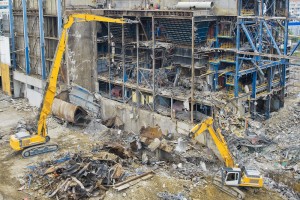Stay Safe When You’re Knocking Down!
 Demolition isn’t exactly the most risk-free of jobs out there – it goes without saying that health and safety measures need to be stepped up when you’re involved with anything related to it!
Demolition isn’t exactly the most risk-free of jobs out there – it goes without saying that health and safety measures need to be stepped up when you’re involved with anything related to it!
And a recent story highlights the importance of it very sharply. A marine demolition company now faces a fine of £42,000 after a tragic accident took place, leaving a worker’s legs trapped beneath a section of a metal barge being dismantled.
Could it have been avoided? In fact it could – the company in question had identified risk factors – but never put any follow up control measures into place!
So if you’re demolishing or dismantling something, what kinds of risk factors should you be on the look out for?
And what should you do to stay safe?
Identify the risks
The risks that you could be facing on any demolition work really depend on the kind of work taking place, so there’s no one-size-fits-all solution.
That means you need to stay alert and pay attention!
Are there likely to be building openings, or partially demolished floors? There could be a risk of falling from height – even if you don’t think so at first.
Demolishing buildings inevitably is going to result in a lot of debris and material falling – which can pose another serious risk to both workers and passers-by. Keep exclusion zones and hard hat areas where there’s the greatest risk of debris, and try to keep walkways covered up.
Make sure you carry out a structural survey
You’ll need to be aware of the building or structure’s own possible risk factors, so a survey is essential.
This will help you answer some important questions and identify possible risks – how old is the building and how was it constructed? Are there other buildings near by? What’s the weight of the material or machinery on any floors above the ground floor?
Based on this information, you can decide on the safest way to carry out the demolition process.
Be wary of hazardous materials
As well as larger pieces of debris, there’s likely to be some hazardous material that could be airborne, and cause serious health damage. Some of the biggest culprits are dust, asbestos and respirable crystalline silica.
Then there are the materials that might not have been cleared fully from the old building, such as paints and flammable liquids, or chemicals from industrial processes.
Be alert when it comes to noise and vibration
Damage from intense vibration and loud noises may not be as obvious as some of the other risk factors around – but they’re no less serious!
Frequent exposure to loud noises can permanently damage a person’s hearing – and using vibrating hand tools can lead to hand-arm vibration syndrome. So make sure that anyone at risk of these issues has been properly trained, and given adequate respite from exposure.
Employ the right contractor
Selecting the right contractor to do the right job is key. So make sure that you engage a company with knowledge and experience for the job in hand, you don’t want to employ a contractor without checking their competence. Getting that right will help avoid problems further down the line.
Your takeaway points
There’s a lot to be wary of when it comes to building demolition, including:
- Risk of falling from heights – both outside and inside buildings with partially demolished floors
- Falling material and debris
- Hazardous materials, including chemicals, dust and asbestos
- Noise and vibration damage
- employee a competent contractor.
Are you involved in demolition? What are your health and safety concerns about it?

A chartered (fellow) safety and risk management practitioner with 20+ years of experience. David provides a healthy dose of how-to articles, advice and guidance to make compliance easier for construction professionals, Architects and the built environment. Get social with David on Twitter and Linkedin.

 Demolition isn’t exactly the most risk-free of jobs out there – it goes without saying that
Demolition isn’t exactly the most risk-free of jobs out there – it goes without saying that 

2 Comments
Please add about Crowd Control as the dust often goes over the crowd that watches They often stay there all day watching and have picnics ,If all the asbestos has been removed (which isn’t always the case) Fibre Glass insulating is often seen blowing all over the crowd and all that dust make people ill as well.
An excellent point Mavis. Thanks for dropping by and commenting